| Back to Back Issues Page |
 |
|
Bangkok Travelbug September 2018 Mon Temples in Pathum Thani September 04, 2018 |
| Hello
Brief History of the Mon The history of the Mon goes back several centuries, the first kingdom was established in Thaton, 110 km east of Yangon in the 9th C. Thaton was sacked by the Burmese 1057. In 1287 the Mon established the Hanthawaddy Kingdom in the lower Irrawaddy with their capital in Pegu (present-day Bago) 65 km northeast of Yangon. Pegu was captured by the Burmese in 1539 and Martaban (Moke Tha Ma) in 1541. The Hanthawaddy Kingdom was re-established in Pegu in 1740 only to be sacked again in 1757. This time the Mon Kingdom was completely crushed. The Mon were dispersed, others fled to Siam during the Ayutthaya period. Many of them settled along the banks of the Chao Phraya and built several temples in an area known as Sam Khok in Pathum Thani. Being skilful potters, they built three earthen kilns to heat their pots and jars. These kilns looked like huge moulds of earth and gave the place its name Sam Khok (sam – three, khok – moulds) 
An old kiln creating a huge mould on the ground All five temples are located on the west bank of the Chao Phraya. Except for Wat Hong Pathummawat which is in Pathum Thani City, the rest are in Sam Khok District. Contents Wat Hong Pathummawat Wat Hong Pathummawat was built during the Thonburi era, in the reign of King Taksin the Great (1776 – 1782). This is the only one of the five temples that is in Pathum Thani City. The temple was originally called Wat Hongsa after the hongsa (pronounced hong) or swan that symbolises Pegu the capital of the Mon Kingdom. There is a mast with a hongsa at the top near the river, the symbol of the Mon and a characteristic of Mon temples. The hongsa mast usually has a banner attached to it, this banner is called the centipede flag and represents the giant centipede found on a mountain where some of Buddha’s hair is kept. The centipede is deemed to be Buddha’s flag and represents Buddhist teachings. 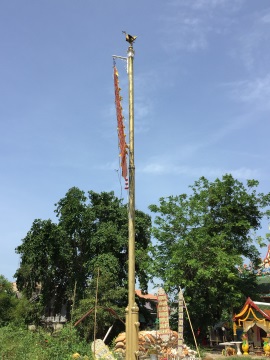
Hongsa mast with centipede banner The beautiful ubosot is at the top of a flight of stairs. Unfortunately, it was locked and we couldn’t get to admire the interior. 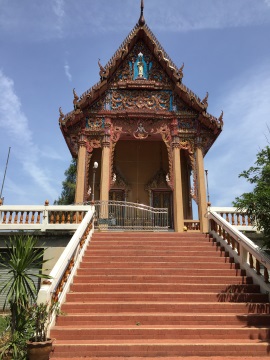

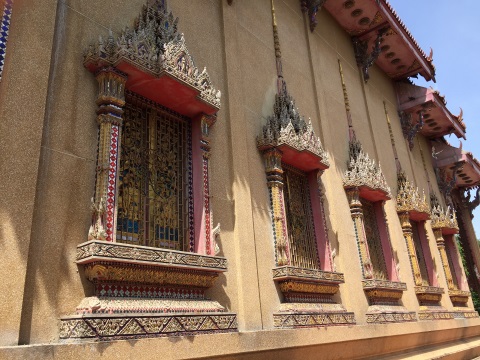
The ubosot from different angles The memorable feature of this temple is the fish sanctuary on the Chao Phraya. I haven’t seen such densely packed shoals of fish in any of the other temples I’ve visited. It’s a marvel to watch them as they break the surface to feed. The fish here are the pla sawai or the iridescent shark catfish. This is because it resembles a shark in shape and gives off a glowing stripe along the body. 

Pla sawai on a feeding frenzy Contents Wat Sing Wat Sing is believed to be built during the Ayutthaya era though records can’t pin-point the exact date. There are a number of attractions in this old temple. The first is the temple museum which used to be the monks’ quarters (kuti). Besides old Mon pottery the museum preserves a wooden bed which King Rama II slept on when he visited Wat Sing and a teak reproduction of Buddha’s footprint. 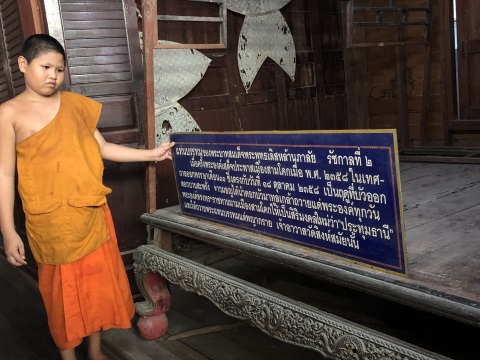
Novice showing us the bed which King Rama II slept on during his visit to Wat Sing 
Reproduction of Buddha’s footprint carved in teak 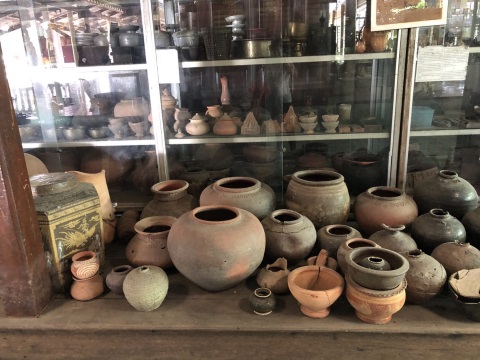
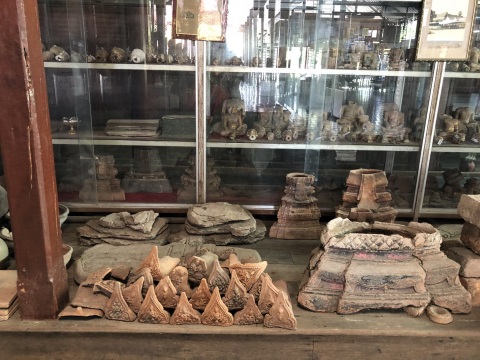

Mon antiques in the museum The Viharn Thong or Sala Din houses two Buddha images in memory of former abbots of the temple. One image is in the sitting position dedicated to Luang Pho To, just behind it is another image of the reclining Buddha dedicated to Luang Pho Phet. 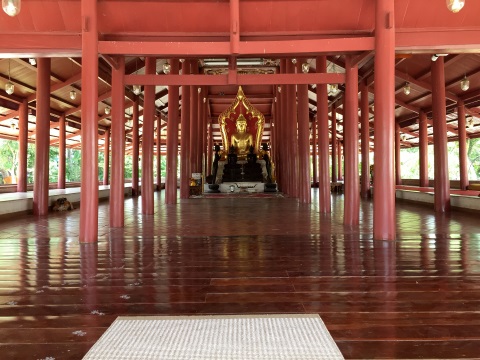
The Viharn Thong or Sala Din 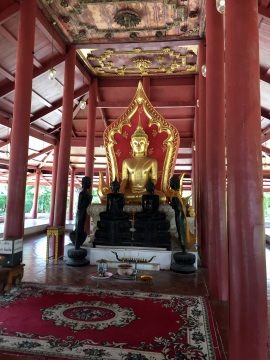
Buddha image in the sitting position dedicated to Luang Pho To 
Reclining Buddha image dedicated to Luang Pho Phet A cluster of old buildings to the east consists of the ubosot (ordination hall) and viharn noi (little viharn, viharn – sermon or assembly hall). 
Cluster of old buildings, ubosot (left), urn (centre) and viharn noi (right) 
The bare interior of the ubosot 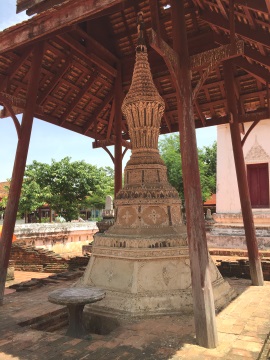
Kod Phaya Krai – the urn holding the remains of Phaya Krai the abbot of Wat Sing in the reign of King Rama II Just across the road from Wat Sing is the remains of one of the kilns which gave Sam Khok its name. We dropped in to take a look before moving to the next temple. 


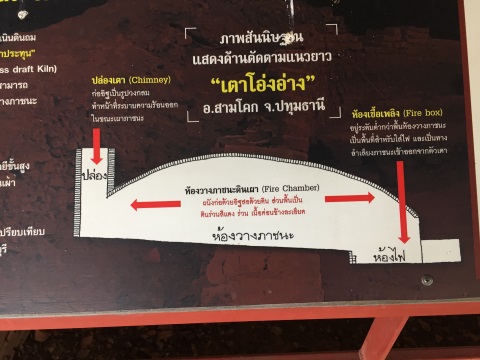
Different views of the kiln including the cross section We are grateful to the novice monk for showing us around the temple museum and for the information booklet on Wat Sing. Contents Wat Sakae From the information board, Wat Sakae was built in 1572 by Mon immigrants. The building that caught our eye was this glittering structure which is the mondop or scripture hall. The board in front displays the donors for the construction of the mondop. 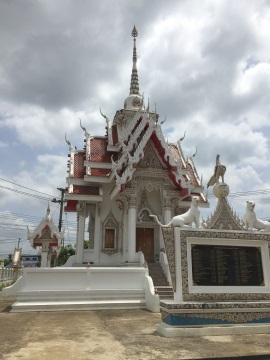
The mondop in Wat Sakae 
The list of donors The ubosot is a new building built over the site of the old one. The viharn located in a remote corner of the temple grounds looks really old. 

The new ubosot 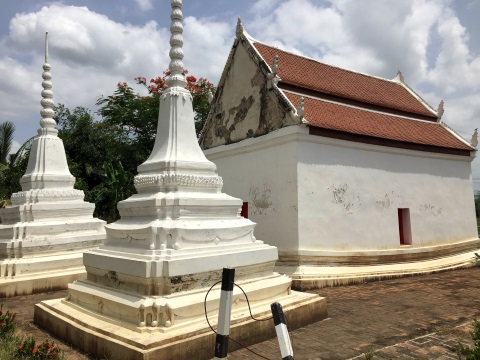
The old viharn Contents Wat Chedi Thong Wat Chedi Thong was constructed in the Ayutthaya era but abandoned after the fall of Ayutthaya in 1767. In the Thonburi and early Rattanakosin eras, Mon from Martaban (Moke Ta Ma) migrated here and expanded on the temple. This is the golden chedi that gave the temple its name. 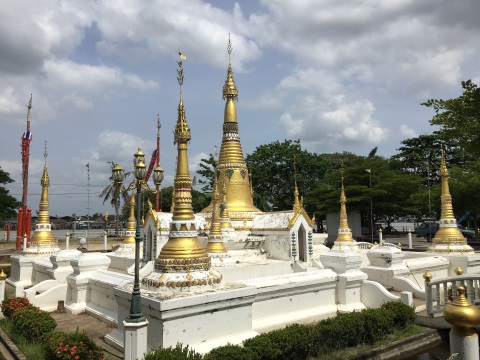
The golden chedi The railings of the stairs leading to the ubosot are lined with the Naga serpent. 
The ubosot There are a number of the familiar hongsa masts with the centipede banners fluttering in the wind. 
The hongsa masts Contents Wat Bot Our last stop was at Wat Bot which was constructed in 1621. You can’t miss this temple with its huge statues. The first statue is of Luang Pho Sothon, the a very revered Buddha image in Thailand. The original Luang Pho Sothon statue is kept in Wat Sothon in Chachoengsao. 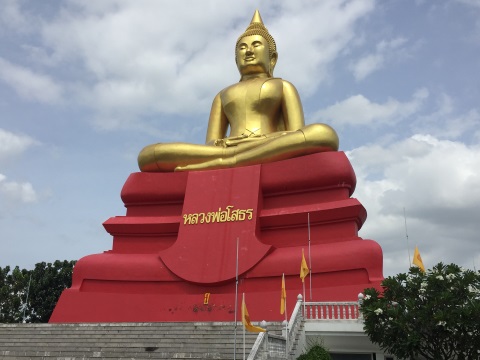
Luang Pho Sothon The other statue is of Luang Pho Toh a highly respected monk who was a great advocate of education. 
Luang Pu Thian Besides a bustling weekend market in Wat Bot, there is the usual fish sanctuary swarming with fish. 
Weekend market in the temple grounds 
Fish sanctuary A small museum preserves some of the pottery from the Sam Khok kilns as well as from China. 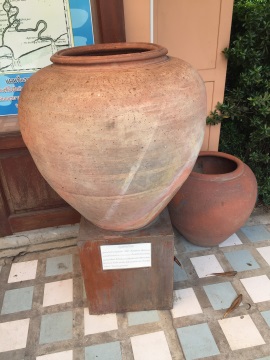
The Sam Khok urn or Yi Leung in the Mon language 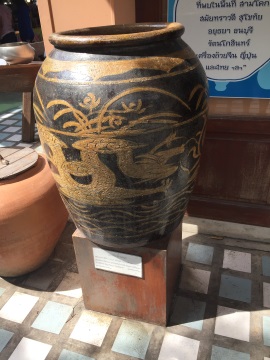
Urn from Jiang Su, China In the old days, people had their baths by scooping water from these urns. This was before the showers and hot water heaters were introduced. With that we end our tour of the Mon temples in Pathum Thani. It was back to highway 9 and home after a pleasant and interesting Saturday outing. See you next month. Contents Map to the Mon temples in Pathum Thani If the map doesn’t appear, click on this link How to get there By car Highway 9 or Sirat/Udon Ratthaya Expressway – highway 346 – Pathum Thani City where Wat Hong Pathummawat is located. From Wat Hong – highway 3111 – Wat Sing. From Wat Sing take the road running along the banks of the Chao Phraya to Wat Sakae. From Wat Sakae get back to highway 3111, make a U-turn and turn into the lane leading to Wat Chedi Thong. From Wat Chedi Thong – Chonlaprathan Alley - Wat Bot. Contents Next month Wat Chedi Hoi the chedi of shells Pathum Thani. If you enjoyed reading this e-zine, please forward it to a friend. If you received this from a friend and found it interesting, please subscribe at Bangkok Travelbug. What do you think of the Bangkok Travelbug? We love to hear from you What other subscribers have said Till next month then. Eric Lim Tour Bangkok Legacies Find us on Facebook My Journey through Thailand Part I The First Steps This is my second e-book and the first in the series of travel journals on my trips to explore the various provinces in Thailand. This edition, which covers my travels from late 2009 to mid-2013, will guide you to historical sites, cultural monuments and exquisite Thai handicraft, across a vast spectrum of cultural and ethnic diversity. You can have a virtual tour with this e-guide book or take the first steps yourself in this journey through Thailand. My Kindle e-book 
Copyright@2008-2018 Tour Bangkok Legacies All rights reserved |
| Back to Back Issues Page |
